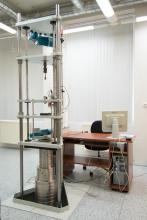 Name of Standard: National ESZ force standard 3 kN
Name of Standard: National ESZ force standard 3 kN
Code designation: ECM 150-4/06-031
Year of publication: 2006
Department: nr. 8011 CMI LPM Praha
Guarantor: Ing. Lukáš Vavrečka Ph.D.
Number of CMC lines provided: 1
| Mode | Scope | Uncertainty (k = 2) |
| Tensile loading | 30 N – 3000 N | 5·10-5 |
| Compressive loading | 30 N – 3000 N | 5·10-5 |
The state standard ESZ 3 kN is designed for calibration of standard force gauges with nominal forces up to 3 kN under tensile and compressive loading.
The standard was developed and constructed by the staff of the force and moment of force department of CMI LPM Prague under the direction of Ing. M. Chlumský as a replacement for the original standard, which no longer met the requirements for the primary force standard. The production of the parts was carried out in cooperation at MP NÁSTROJÁRNA in Úpice and at KOVO IDA in Malé Svatoňovice. The construction of the standard was carried out during the construction of the new force laboratories. For this reason, the standard was installed in a spare laboratory on the premises of VZLÚ in Letňany. The standard was completed in 2002. After the completion of the force laboratories in Prague 5, the standard was transferred to this laboratory. It was put into operation in 2005. Through theoretical and experimental work in 2002-2005, the team of the force department managed to prepare the standard scientifically and technically for the announcement as a state standard, which was successfully carried out in 2006.
The calibration force of the standard is generated by the action of the earth's gravitational field on the load bodies of the standard. The standard has one load cell system, which contains 28 load cells made of stainless austenitic steel.
The force generated by the standard is given by the equation:
Where stands for:
F | ...........…. | the power generated by the standard, |
m | ...........…. | the weight of the load bodies, |
g | ...........…. | the gravitational acceleration at the location of the load bodies, |
ρvzd | ...........…. | air density at the location of the load bodies, |
ρZT | ...........…. | density of load bodies. |

